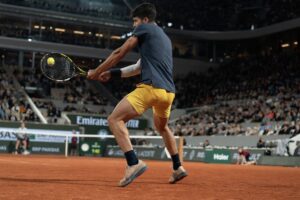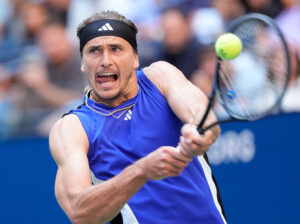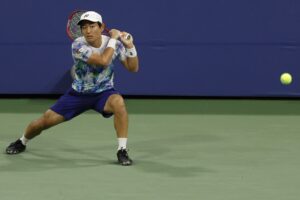Johanna Konta may have ended 2017 on a low, limping out of the Asian swing of the WTA tour and then parting from her coach Wim Fissette, but at least the rest of her year had gone remarkably well, especially the run to the Wimbledon semi-finals that briefly raised British hopes of having a home female Wimbledon champion for the first time in 40 years. By stark contrast, the two other supposed “golden girls” of British tennis – Laura Robson and Heather Watson – barely seemed to get going at all this year. Indeed, it is now questionable whether they have ever really got going in the last decade or so, since they first emerged as Junior Grand Slam winners.
July 2018 will mark the 10th anniversary of Robson’s Junior Wimbledon triumph, when she beat the No. 1 seed, America’s Melanie Oudin, en route to the final and then defeated Thailand’s Noppawan Lertcheewakarn in the final. Britain had produced both male and female Junior Wimbledon winners before (ranging from Stanley Matthews Junior in 1962 to Annabelle Croft in 1984), none of whom had gone on to challenge seriously at the Senior Majors, but Robson seemed different. Partly that was because of her birth and upbringing in the sporting hothouse of Australia (for a while after she won Junior Wimbledon, Pat Cash still insisted on calling her “Aussie Laura”), but it was also because her run to the final and subsequent triumph in it attracted far more attention and publicity than those of previous British Junior Wimbledon champions. Her final was televised live on the BBC in “prime time” on Saturday night, only a few hours after the Women’s Singles final between the Williams sisters, and when she won she was immediately catapulted into the wider British sporting consciousness.
And she was not alone, as just over a year later Heather Watson won the 2009 Junior US Open, by beating Russia’s Yana Buchina in the final in New York. A mere five years earlier, Andy Murray had won the boys event at Flushing Meadows, and given his stunning rise up the senior ranks in the following half-decade there was genuine hope that Watson, along with Robson, might be able to follow his lead.
Of course, it has not worked out quite like that, and the first thing to be said is that Robson and Watson are certainly not unique in that respect. Just as in any other professional sport, relatively few young tennis champions ever translate their youthful triumphs into more lasting success. As the saying goes, “Those whom the gods wish to destroy, they first call promising,” and that has certainly been true of Robson and Watson’s aforementioned opponents in 2008 and 2009. Melanie Oudin actually retired from tennis in August of this year, citing seemingly endless illness and injury problems as the cause, while both Lertcheewakarn and Buchina have failed to crack the women’s top 100. Indeed, as both of them have appeared recently to concentrate on doubles as much as on singles, they might end up following Jamie Murray (who, of course, was a hugely promising Junior himself) rather than Andy and become doubles specialists.
While neither Robson nor Watson have yet reached the stage of either contemplating retirement or focusing on doubles, they have undoubtedly suffered from serious illness and injury. In Robson’s case, the worst problem has been ongoing difficulties with her left wrist, which, as a natural left-hander, has been devastating, while Watson suffered a bout of glandular fever in 2013, from which she has arguably never fully recovered.
The result has been that both women have struggled to maintain the long-term fitness, and with it the consistency of play, that is necessary to rise up the rankings, with Robson reaching a career high ranking of 27 in 2013 (she is currently just ranked inside the world’s top 250) and Watson reaching a career high of 45 in the same year (and she is currently ranked just inside the world’s top 100).
The same has been true of their performances at the Senior Majors, i.e. the Majors proper. Their overall record is patchy, if not poor, with only sporadic highlights in the last five years or so. Robson enjoyed a spectacular first week at the US Open in 2012 (building on the silver medal that she had won earlier that summer in the Olympic Mixed Doubles with Andy Murray), when she defeated both Kim Clijsters and Li Na before succumbing to the defending champion, Sam Stosur. For Watson, the undoubted highlight of her career since winning the Junior US Open was her run to the third round of Wimbledon in 2015, when she nearly defeated her idol, Serena Williams, before Serena won through in three sets.
This year, both women’s struggles with fitness and form have only seemed to intensify. Watson has had a largely indifferent 2017, as was demonstrated again this week when she lost in the quarterfinals of the Luxembourg Open, an “International Series” (read, fairly lowly) event, to Elise Bertens of Belgium, while Robson has barely played at all in the last 12 months. In fact, her most visible public sighting in recent months was after the appalling Las Vegas shooting, where she was part of the crowd at the country music concert that was attacked but mercifully survived the mass slaughter.
Perhaps what has made the difficulties that both Robson and Watson have experienced even worse is the utterly unexpected rise of Johanna Konta. Unlike her two British peers, Konta was not a Junior Grand Slam champion. Even worse, in Australia, where Konta (like Robson) was born and grew up, she was not identified as a possible future champion at all, which was partly why she and her family eventually followed Robson and decamped to Britain. But in the past two years, Konta has thrown off the mental shackles that seemed to constrain her for so long (especially after her work with the now deceased mental coach, Juan Coto). Consequently, she has become a regular member of the World’s Top 10 and a two-time Major semi-finalist, with hopes of faring even better at a Grand Slam in 2018.
It had been thought that the presence in the same generation of three potentially outstanding young women would strengthen Britain’s chances in the Fed Cup. Certainly, Judy Murray seemed to think so when she became Fed Cup captain in 2011, but she was unable to repeat the success she had enjoyed in coaching her own sons and eventually quit in 2016 after five unsuccessful years. And even after Konta’s breakthrough and the introduction of a new Fed Cup captain in Anne Keothavong, Britain succumbed fairly meekly to Romania in April, although it must be acknowledged that the appalling behaviour of Romania’s captain, Ilie Nastase, was a contributing factor, with Konta being particularly affected by his odious name-calling and verbal harassment.
Thus, Britain’s best three women players (whatever the rankings say, Robson is more talented than Naomi Broady, Britain’s current No. 3) find themselves at a crossroads as they prepare to enter the off-season and regroup for 2018. However, while Konta is firmly looking up and searching for the new coach who can finally help her to get to a Grand Slam final and perhaps even win it (and the candidates being talked about include such stellar names as Justine Henin), Watson and Robson are facing a struggle just to survive, not only financially (given how poor their recent performances have been) but more importantly in sporting terms.
As a result, 2018 is already looking like something of a “make or break” year for them both. Nearly 10 years on from their magnificent Junior successes, both women now face the fight of their lives, not to become Senior Major winners but simply to keep playing the game they love.






